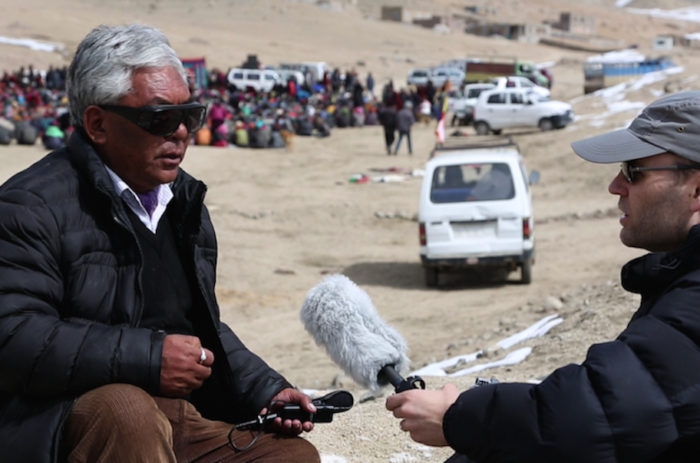
Seattle filmmaker Erik Koto, devoted six years to directing and producing “The Song Collector”: a story about the fight to preserve a singular Buddhist culture in Ladakh, India.
And to say that the “song collector” featured in it, Morup Namgyal, made it all worth his while, is an understatement. This cultural preservation activist has seen his pristine and singular Buddhist culture diminished in the face of war and globalization. Since the ’60s, he has built a movement and a crop of Ladakhi schools to protect it.
“What Morup is doing is inspirational and a great tale: from the grass roots, [Ladakhis] can make a difference in their region and culture,” says Koto.
Situated on the edge of the Tibetan Plateau, Ladakh maintained an enduring presence as an independent Buddhist kingdom for centuries, but its culture quickly eroded beginning in the mid-1960s, when the Indian government constructed a road into its kingdom to defend its borders from China and Pakistan. This set Ladakh on a faster track to modernization.
Namgyal has walked hundreds of miles collecting and documenting 1,300 songs to recover Ladakh’s lost oral history.
Koto first met Namgyal in 2009 while producing a short film for a fledgling Ladakhi school. Since the activist is a national hero with a household name throughout India, he was struck by Namgyal’s humble, hospitable and soft-spoken nature.
“I found him to be a magnetic personality. That’s when I realized this is someone who could convey his story and could be a character on film,” Koto remembers.
The introduction and short film he made about the school in 2009 snowballed into the 54-minute “Song Collector” documentary showing at Northwest Film Forum tomorrow night, where both Namgyal and Koto will be present.
The songs Namgyal collected are a window into many of the parts defining Ladakh’s past, including its unique language and pristine landscape.
Namgyal’s song collection is also a community cultural repository. In the long-held oral tradition, a folk song is sung with every stage, aspect and major milestone in life, like marriage and cultivating agriculture. Other songs reflect the dying language and historical milestones, like when India’s economic pressure began spurring new development to displace the Ladakhi way of life. These song stories are especially significant to a people who have no written tradition of passing on history to the next generation.
“Folk singing is a very generational and hereditary pursuit,” Koto adds. “Namgyal’s family is an important example of this. Even his grandson is learning about his homeland and culture through the songs’ lyrics and language.”
Namgyal’s grandson attends the Ladakhi school his grandpa started, which teaches the people’s history and language, Bhoti, through song. The schools Namgyal started have had a broad impact: more than 2,000 students on eight campuses now attend these schools, which graduate 100 students per year, says Koto.
“Song Collector” film editor Gretchen Burger relates to the larger themes of Namgyal’s story, and believes that others who struggle to live in the modern world, will, too.
“You know, in a way, it takes a small story to tell a big story. And, if we do it right, there’s that important theme about a very universal quality of life,” she explains.
Though Koto, an executive at Seattle-based company QuestionPro, says he misses the Ladakh people, he probably won’t miss the traditional music.
“Ceremonial music is loud and not particularly soothing, but the lyrics have a very important story that only revealed itself later,” he says.
One was “Leh Palace,” written in the 16th century. The song describes the lama who blessed the cornerstone of the Leh Palace, which according to Koto, is like the Eiffel Tower of Ladakh. It also recounts the construction and opening of the palace. This history is only documented in song.
Though his appreciation for the stories and even the music have grown over time, “it won’t be something I run out and buy a CD of,” Koto chuckles.
Looking back on his experience over six years, Koto says that he finds the film has already been a huge success, which to him, equates to the level of personal reward that he feels.
The film gave Koto major opportunity to explore a fascinating culture. Most of all, it gave him the opportunity to tell the story of Namgyal, a major force in India. To this day, Koto feels humbled to tell it, says Koto.
“One of the things I’m most proud of is that I didn’t hurry the film to get done.”
Meet Koto and inspirational Namgyal himself at a 6 p.m. screening of “The Song Collector” tomorrow, June 5 at Northwest Film Forum: 1515 Twelfth Avenue in Seattle’s Capitol Hill Neighborhood. Tickets and more at www.nwfilmforum.org.
Editor’s note: Gretchen Burger is a film editor, not a story consultant, to “The Song Collector.” The story has been updated since its original publication to correct this error.


India has long been the birthplace of Buddhism. It was great to be able to film a Buddhist film here. In Vietnam Buddhism is very developed as well as the culture of burning money and gold and gold in Buddhism